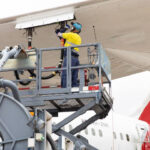Sustainable aviation investment company SkiesFifty is to partner with Frontline BioEnergy to advance commercialisation of the latter’s proprietary and patented gasification technology that converts biomass and waste into clean renewable fuels, including sustainable aviation fuel. They will jointly own and invest in a new company that will focus on scaling up SAF production in sites across the US and potentially globally. SkiesFifty has also agreed to purchase 200,000 carbon credits over four years through a strategic investment in marine-based carbon removal company Gigablue, which is aiming to permanently remove a gigaton of carbon dioxide by 2035. Over the past year, SkiesFifty has also invested in sewage-to-SAF startup Firefly and teamed with Catalsys to develop green power solutions for aviation ground operations.
Under the US partnership, the new venture will deploy Frontline’s gasification technology on its own projects as well as licensing it to others. In addition to SAF production, it also plans to produce green methanol as a transportation fuel for the maritime sector.
“Our proprietary technology creates clean, tar-free and particulate-free synthesis gas. It has huge potential for the generation of SAF. We have been looking for the right partner and investor to unlock this market for some time,” said Jerod Smeenk, CEO of Frontline BioEnergy. “SkiesFifty will now enable us to enter into SAF production and commercialise it on a global scale.
“Through transforming waste into clean energy, we are unlocking new possibilities for renewable fuel production and contributing to a more sustainable future.”
In July 2024, SkiesFifty, financial services and venture capital firm RAIN, and Gigablue announced a strategic partnership that aimed to scale up Gigablue’s ocean-based carbon removal system, increase awareness of the technology and manage distribution of the carbon credits it generates within the aviation and other hard-to-abate industries. The partners say the aviation industry is increasingly looking to carbon removal solutions because of the widening gap between the supply of SAF and industry demand. They quote IATA estimates that by 2050, removals alone will account for 20% of the aviation sector’s abatement efforts.
Under the partnership, Gigablue and SkiesFifty are working with the financiers at RAIN, which incubated SkiesFifty, to leverage RAIN’s investing experience and relationships in the financial services and technology industries.
“With the support of SkiesFifty and RAIN, we can accelerate the adoption of Gigablue’s environmentally safe and financially suitable carbon capture technology, ensuring impactful carbon removals for airlines striving to reach net zero,” said Ori Shaashua, co-founder and Chief Business Officer, Gigablue.
The new agreement for 200,000 credits over four years, said Shaashua, would be the largest marine carbon dioxide removal offtake agreement to date “and proves our technology’s viability in the market.” He said more offtake agreements would be announced shortly.
The company says its technology offers a low-cost route to sequestering carbon, relying on marine carbon fixation and sequestration (MCFS). At the heart of the solution is a novel substrate consisting of a contained nutrient shell and a gravity-controlling core that acts as an optimal environment for local phytoplankton to grow and thrive. Once the phytoplankton multiply and reach a sufficient amount, a controlled sinking trigger activates and the substrate, together with the attached carbon, sinks to the bottom of the ocean for permanent storage – over a thousand years, claims the company.
“Using nothing more than sunlight, water and gravity, Gigablue can safely and efficiently store carbon dioxide at a gigaton scale,” it says.
Its proprietary oceanographic platform integrates hundreds of geoinformation data points using artificial intelligence to identify optimal deployment zones and predict the most effective substrate particle compositions.
Gigablue’s MMRV (measurement, monitoring, reporting and verification) framework has been reviewed by New Zealand’s National Institute of Water and Atmospheric Research to ensure reliable and measurable carbon sequestration, while supporting marine ecosystems, said the company.
“At SkiesFifty, we invest in the technologies that will make a difference to a carbon-neutral future for aviation,” said Simon Talling-Smith, founding partner at SkiesFifty. “We are constantly evaluating projects and we were deeply impressed by Gigablue’s ocean-based CDR solution. It stood out due to its combination of environmental safety, durability, scalability and robust scientific measurement. We believe CDR will be an important part of the portfolio of solutions that will lead us to net zero for aviation by 2050.”
Photo: Gigablue














More News & Features
LanzaJet and KMG agree to progress SAF production project in Kazakhstan
SkyNRG says e-SAF and carbon removals should not be competing strategies for aviation decarbonisation
South Korea announces mandatory SAF blending for departing international flights from 2027
Catagen launches SAF production company and signs offtakes with Ryanair and Shell
Australia announces A$1.1bn incentive scheme to drive local production of low carbon fuels including SAF
Oneworld airline partners join with Breakthrough Energy Ventures to invest in new SAF technologies